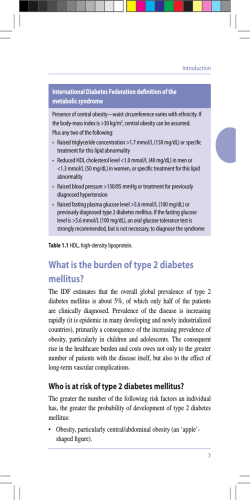
Anti-diabetic activity of compound isolated from Physalis angulata
The Ame J Sci & Med Res, 2015, Volume 1, Issue 1; http://dx.doi.org/10.17812/ajsmr2015111 Article Options Abstract Full Text-PDF Cite This Article Anti-diabetic activity of compound isolated from Physalis angulata fruit extracts in alloxan induced diabetic rats Porika Raju and Estari Mamidala Department of Zoology, Kakatiya University, Warangal-506 009. Telangana State, India E-mail: raju42648@gmail.com Abstract Excessive food consumption regarding to high calorie, obesity, cardiovascular disease, stress, and lack of exercise are risk factors for diabetes mellitus (DM). One alternative therapeutic approach in DM patients is traditional use of herbal medicines such as Physalis angulata herbs. The aim of the study was to evaluate the anti-diabetic effect of isolated compound from P. angulata in alloxan induced diabetic rats. Anti-hyperglycemic effect was investigated in normal and alloxan induced diabetic rats. Glibenclamide (150 mg/kg, p. o.) were used as reference drugs for comparison. The active compound was isolated by using chromatographic techniques. The isolated compound significantly (P<0.05) reduced blood sugar level in alloxan induced diabetic (hyperglycaemic) rats orally at 25 mg/kg and 50 mg/kg body weight respectively. The findings of this experimental animal study indicate that the compound isolated from P. angulata fruit extract possesses antihyperglycemic properties; and thus lend pharmacological credence to the folkloric, ethnomedical uses of the plant in the treatment and as well as in the management and/or control of type 2 diabetes mellitus. Key words: Physalis angulata, Diabetes mellitus, Antihyperglycemic, OGTT and herbal medicines. Published online on 16th April, 2015 © 2015 Published by Global Science Publishing Group, USA How to Cite this Article Porika Raju and Estari Mamidala (2015). Anti-diabetic activity of compound isolated from Physalis angulata fruit extracts in alloxan induced diabetic rats. The Ame J Sci & Med Res, 2015,1(1); Pages 1-6. doi:10.17812/ajsmr2015.11.1 Link to this article: http://globalsciencepg.org/ajsmr/10.17812ajsmr2015111.html [1] Akhtar, M. Rashid, M. I. I. Wahed et al., “Comparison of long-term antihyperglycemic and hypolipidemic effects between Coccinia cordifolia (Linn.) and Catharanthus roseus (Linn.) in alloxan-induced diabetic rats,” Research Journal of Medical Sciences, vol. 2, pp. 29–34, 2007. [2] Chiang HC, Jaw SM, Chen CF, Kan WS. Antitumour agent Physalis.F from Physalis angulata. Anticancer Res. 1992; 12(3):837–843. [3] Collins, J. Armitage, S. Parish, P. Sleigh, and R. Peto, “MRC/BHF heart protection study of cholesterol-lowering with simvastatin in 5965 people with diabetes: a randomized placebo-controlled trial,” The Lancet, vol. 361, pp. 2005–2016, 2003. [4] D. Krishna Gopal Rao. 2013. Hypoglycemic activity of extracts from Elytraria acaulis L. Leaves in alloxan-induced diabetic rats. Biolife. 1 (1):1 1 -16, 2013 [5] Devdatta Gopal Lad. 2014. A comparative histopathological remedial study of polyherbal formulation Diabcure and Glibenclamide on Streptozotocin induced diabetic rats. Biolife 2(4);1376-1379 [6] E. Sucharitha and M. Estari. 2013. Evaluation of antidiabetic activity of medicinal plant extracts used by tribal communities in rural areas of Warangal district, Andhra Pradesh. Biology and Medicine, 5.20-25). [7] G. Krishna and M.A Singara Charya V. Pranitha. 2014. Evaluation of antibacterial and anifungal activity of fruiting body extracts of Trametes versicolar. 2(4). 1181-1184 [8] Holt, “Diagnosis, epidemiology and pathogenesis of diabetes mellitus: an update for psychiatrists,” British Journal of Psychiatry, vol. 184, pp. S55–S63, 2004. [9] Januário AH, Rodrigues Filho E, Pietro RCLR' S, Kashima S', Sato DN, Fraça SC. Antimycobacterial physalins from Physalis angulata L. (Solanaceae) Phytother Res.2002;16(5):445–448. [10] Nair, M.G., Jayaprakasam, B., Olson, L.K., Schutzki, R.E. Methods and compositions for the treatment of obesity, insulin related diseases and hypercholesterolemia. US20060025354 (2006) & US20110003762 (2011). [11] Nathan, “Long-term complications of diabetes mellitus,” New England Journal of Medicine, vol. 328, no. 23, pp. 1676–1685, 1993. [12] Patel PM, Patel KN, Patel NM, Goyal RK. Development of HPTLC method for estimation of charantin in herbal formulations. Pharmacog Mag. 2006;8:224–6. [13] Pietro RC, Kashima S, Sato DN, Januário AH, Franca SC. In Vitro antimycobacterial activities of physalis angulata L. Phytomedicine. 2000;7(4):335–338. [14] Rajendra Prasad Gujjeti and Estari Mamidala. Anti-HIV Activity and Cytotoxic Effects of Aerva lanata Root Extracts American Journal of Phytomedicine and Clinical Therapeutics. 2014. 2(7) 894-900. [15] Raju Porika, Sateesh Poojari, Venkanna Lunavath and Estari Mamidala. 2014. Preliminary Phytochemical Investigation and TLC Analysis of P. Angulata Fruit Extract. Journal of Pharmacy and Biological Sciences. Volume 9, Issue 2 .11-14. [16] Sateesh Poojari, Raju Porika and Estari Mamidala. Phytochemical Analysis And In Vitro Antidiabetic Activities Of Physalis angulata Fruit Extracts.. National Journal of Integrated Research in Medicine (NJIRM) 2014; Vol. 5(2).34-38. [17] Van Valkenburg JLCH, N Bunyapraphatsara, editors. Medicinal and Poisonous Plants 2.Bogor, Indonesia: Prosea Foundation; 2002. Plant Resources of Southeast Asia No.12 (2) p. 782. [18] Vijayvargia R. Hypoglycemic effect of aqueous extract of Enicostetmma littorale, Blume (Chhota chirayata) on alloxan induced diabetes mellitus in rats. J Exp Biol 2000; 38:1-8. [19] Vinatha Naini and Estari Mamidala. 2013. An ethnobotanical study of plants used for the treatment of diabetes in the Warangal district, Andhra Pradesh, India. Biolife. 1(1):24-28. Wen-Tsong Hsieh, Kuan-Yuh Huang, Hui-Yi Lin, Jing-Gung Chung. Food and Chemical Toxicology. 2006;44: 974–983.
© Copyright 2025










